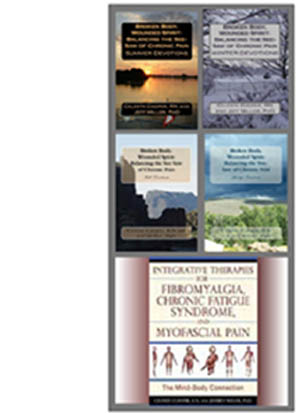The primary presenting complaint in fibromyalgia is muscle
pain, and the primary reason chronic fatigue syndrome (CFS/ME) patients seek
treatment, is life altering fatigue and an overwhelming feeling of illness.
Though in neither case, is this where symptoms stop.
The diagnostic criteria for fibromyalgia (FM), here, and chronic fatigue syndrome (CFS/ME), here, are very specific to each disorder
and are dissimilar in several respects.
Fibromyalgia and CFS/ME (as we refer to in our book,
chronic fatigue immunodysfunction, CFID) do
share some common comorbid conditions, and both are thought to have central
nervous system disruption, however, disruptions are different between the two,
and newer research is showing a stronger connection to viral, infectious, and
immune overload in CFS/ME than seen in FM, though immune problems have been
established in fibromyalgia too. (Behm, 2012). These problems are complex and researchers
are still weeding through research results which allow them to make new
hypothesis and,, hopefully, move the research in a more distinct direction. Learn more about fibromyalgia comorbid
conditions here
and
CFS.ME here.
Fibromyalgia and CFS/ME also share autonomic effects such as
loss of heart rate variability and POTS, however, in a study done by Light, et al (2011) it was
reported “At least two
subgroups of patients with
CFS can be identified by gene expression changes following exercise. The larger subgroup showed increases in mRNA for sensory
and adrenergic receptors and a cytokine [an immune modulator]. The smaller
subgroup contained most of the patients with
CFS with orthostatic intolerance, showed no post-exercise increases in any gene and was defined by decreases in mRNA
for α-2A. FM-only patients can be identified by baseline increases in three genes. Post-exercise
increases for four genes meet published criteria as an objective biomarker for
CFS and could be useful in guiding treatment selection for different subgroups.”
This leads us the discussion on exercise. Study after study
indicates that exercise worsens the symptoms of CFS/ME, yet low impact exercise
is one of the treatment protocols for helping improve body-wide pain in FM. I
propose this could be due to a higher incidence of orthostatic intolerance in
CFS/ME secondary to an underlying viral, infectious, or immune causation.
There are studies indicating that FM patients symptoms are also worsened by
exercise, but I propose this is due to the presence of untreated myofascial
pain syndrome, where the muscles become weak from the presence of myofascial trigger points, learn more here, and
primary deregulation of the HPA axis.
Repeated studies of FM suggest a disruption of the hypothalamus-pituitary-adrenal
axis and oxidative stress, which could result in secondary immunologic
deregulation. In contrast, It is quite possible immunologic deregulation in
CFS/ME is primary and results from a viral or infectious insult. This is where
the differences are exposed.
Myofascial pain syndrome is thought to overlap in both FM and CFS/ME, which massacres research reliability. Researchers are currently
studying muscle tissue irregularities
in both FM and CFS/ME. It is my greatest hope that they
are considering the presence of myofascial pain syndrome, for without this
consideration and examination for the presence of myofascial trigger points;
study results once again become skewed. We discuss
this and other considerations at length in our book (Cooper and Miller, 2010).
There are specific biological differences between FM and
CFS/ME. Also interesting is a study done by Castro-Marrero et al., who suggest their data leads to “the hypothesis that mitochondrial dysfunction-dependent
events could be a marker of differentiation between CFS and FM indicating the
mitochondria as a new potential therapeutic target for these conditions” Both
are considered neuroendocrineimmune disorders, as is Lyme’s disease, Gulf War
Syndrome, Lupus, and others. Though they fall under the same umbrella, they are
different.
We explain the differences and the similarities, why they are
confused and the importance in having the right diagnosis in Chapter One, “All about Fibromyalgia, Chronic Fatigue
Immunodysfunction—The Muster to Master, and Chronic Myofascial Pain—Nerve to
Muscle, and Double Cross". here
All
blogs, posts and answers are not
meant to replace medical advice.
Resources:
Bardal
E, Olsen T, Ettema G et al. 2013. Metabolic
rate, cardiac response, and aerobic capacity in fibromyalgia: a case-control
study. Scand J Rheumatol. [Mar 26 Epub ahead of print].
Behm
FG, Gavin IM, Karpenko O, Lindgren V, Gaitonde S, Gashkoff PA, Gillis BS. Unique immunologic patterns in fibromyalgia.
BMC Clin Pathol. 2012 Dec 17;12(1):25. doi: 10.1186/1472-6890-12-25.
Brewer JH, Thrasher JD, Straus DC, Madison
RA, Hooper D.. Detection of Mycotoxins
in Patients with Chronic Fatigue Syndrome. Toxins (Basel). 2013 Apr
11;5(4):605-17.
Castro-Marrero J, Cordero MD, Saez-Francas N,
Jimenez-Gutiérrez C, Aguilar-Montilla FJ, Aliste L, Alegre-Martin J. Could mitochondrial dysfunction be a
differentiating marker between Chronic Fatigue Syndrome and Fibromyalgia? Antioxid
Redox Signal. 2013 Apr 22. [Epub ahead of print]
Cooper, C and Miller, J. (2010). Integrative Therapies for Fibromyalgia,
Chronic Fatigue Syndrome, and Myofascial Pain: The Mind-Body Connection.
Vermont: Healing Arts Press.
Ge HY, Nie H, Graven-Nielsen T,
Danneskiold-Samsøe B, Arendt-Nielsen L. Descending
pain modulation and its interaction with peripheral sensitization following
sustained isometric muscle contraction in fibromyalgia. Eur J Pain. 2012
Feb;16(2):196-203.
Gerdle
B, Forsgren MF, Bengtsson A, Leinhard OD, Sören B, Karlsson A, Brandejsky V,
Lund E, Lundberg P. Decreased muscle
concentrations of ATP and PCR in the quadriceps muscle of fibromyalgia patients
- A (31) P-MRS study.Eur J Pain. 2013 Jan 30. doi: 10.1002/j.1532-2149.2013.00284.x.
[Epub ahead of print]
Kulshreshtha P, Deepak KK. Autonomic nervous system profile in
fibromyalgia patients and its modulation by exercise: a mini review. Clin
Physiol Funct Imaging. 2013 Mar;33(2):83-91.
Light AR, Bateman L, Jo D, Hughen RW, Vanhaitsma TA, White AT, Light KC. Gene expression alterations at baseline and
following moderate exercise in patients with Chronic Fatigue Syndrome and
Fibromyalgia Syndrome. J Intern Med. 2011 May 26. doi:
10.1111/j.1365-2796.2011.02405.x. [Epub ahead of print]
Klaver-Król EG, Rasker JJ, Henriquez NR,
Verheijen WG, Zwarts MJ.. Muscle fiber
velocity and electromyographic signs of fatigue in fibromyalgia. Muscle
Nerve. 2012 Nov;46(5):738-45.
Olausson
P, Gerdle B, Ghafouri N, Larsson B, Ghafouri B. Identification of proteins from interstitium of trapezius muscle in
women with chronic myalgia using microdialysis in combination with proteomics.
PLoS One. 2012;7(12):e52560.
Perrin RN, Richards JD, Pentreath V, DF. Muscle fatigue in chronic fatigue syndrome/myalgic
encephalomyelitis (CFS/ME) and its response to a manual
therapeutic approach: A pilot study. International Journal of Osteopathic
Medicine xxx (2011) 1e6
Peter C. Rowe, MD, Neuromuscular Strain in CFS. Association News, Research News,
Understanding CFS | 13. JUN, 2012
http://www.research1st.com/2012/06/13/rowe-riww/
(accessed 5-5-2013)
Shang Y, Gurley K, Symons B, Long D, Srikuea
R, Crofford LJ, Peterson CA, Yu G. Noninvasive
optical characterization of muscle blood flow, oxygenation, and metabolism in
women with fibromyalgia. Arthritis Res Ther. 2012 Nov 1;14(6):R236.
Takamoto K, Sakai S, Hori E, Urakawa S, Umeno
K, Ono T, Nishijo H. Compression on trigger points in the leg muscle
increases parasympathetic nervous
activity based on heart rate variability. J Physiol Sci. 2009
May;59(3):191-7. Epub 2009 Feb 21.
Wilhelmina M. H. Behan, MD, FRCPath, FRCP J
Holt, PhD David H. Kay, MBChB Pamela Moonic, BSe. In vitro Study of Muscle Aerobic Metabolism in Chronic Fatigue Syndrome.
Journal of Chronic Fatigue Syndrome, Vol. 5( 1) 1999
1999 by The Haworth Press, Inc. All rights
reserved.












No comments:
Post a Comment